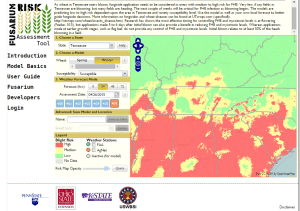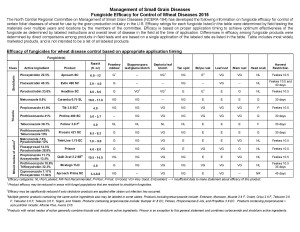So far little disease has been noted in Tennessee, but with the warmer and continuing wet weather that can change. Such weather can particularly lead to high risk for Fursarium Head Blight (FHB or Head Scab) infection.
As wheat gets closer to flowering check the Fusarium Head Blight Prediction Center (www.wheatscab.psu.edu) for risk levels for your area. This year there is an added feature on the website – variety susceptibility drop-down menu. If you are uncertain about the FHB susceptibility of your variety I would go with the default – Susceptible. Using susceptible variety in the model there are areas in Tennessee ranging from low to high risk for FHB for the next 48 hour forecast, which dwindles to low and some medium risk in the 72 hour forecast (see images below from www.wheatscab.psu.edu, click to enlarge). Go to the forecast website for the most up-to-date information. Although most fields are not quite flowering yet, which is the best timing for fungicide application to protect from FHB. Wheat planted behind corn has a higher probability of FHB infection because pathogen can overwinter on corn residue.

Be aware of your wheat’s growth stage and aware of your own local weather forecast to better guide fungicide decisions at flowering. Only fungicide products that are solo triazoles (FRAC or fungicide group 3 on the label) should be applied for prevention/management of head scab. Products that contain a strobilurin can increase the mycotoxin levels in FHB infected wheat. Products labeled for FHB include: Caramba (good control), Prosaro (good control), Proline (good control), Folicur or other tebuconazole products (fair control), and Tilt or other propiconazole products (poor control). More information on different fungicides and their efficacy on wheat diseases can be found on the table below (click to enlarge) and at UTcrops.com.
NCERA 184 Wheat fungicide table 2015
Research has shown the most effective timing for controlling FHB and mycotoxin levels is at flowering (Feekes 10.5), but applications made 5 to 6 days after initial bloom can also provide a benefit in reducing FHB and mycotoxin levels. Whereas applications made at earlier growth stages, such as flag leaf, do not provide any control of FHB and mycotoxin levels. Initial bloom relates to at least 50% of the heads blooming in a field.
Weather conditions that favor severe Fusarium head blight development include 3 or more days with frequent rainfall, extended periods of high relative humidity, and moderate temperatures (65 to 80 °F). These conditions present before, during, and after flowering favor inoculum production, floret infection, and colonization of developing grains. While optimum temperatures for infection are between 75 and 85 °F, infection can occur at lower temperatures during prolonged periods of high humidity and moisture. Wheat is susceptible to FHB infection at flowering (Feekes 10.5) through early dough stage (Feekes 11.2).



One thought on “Considerations for fungicide application in wheat”
Comments are closed.